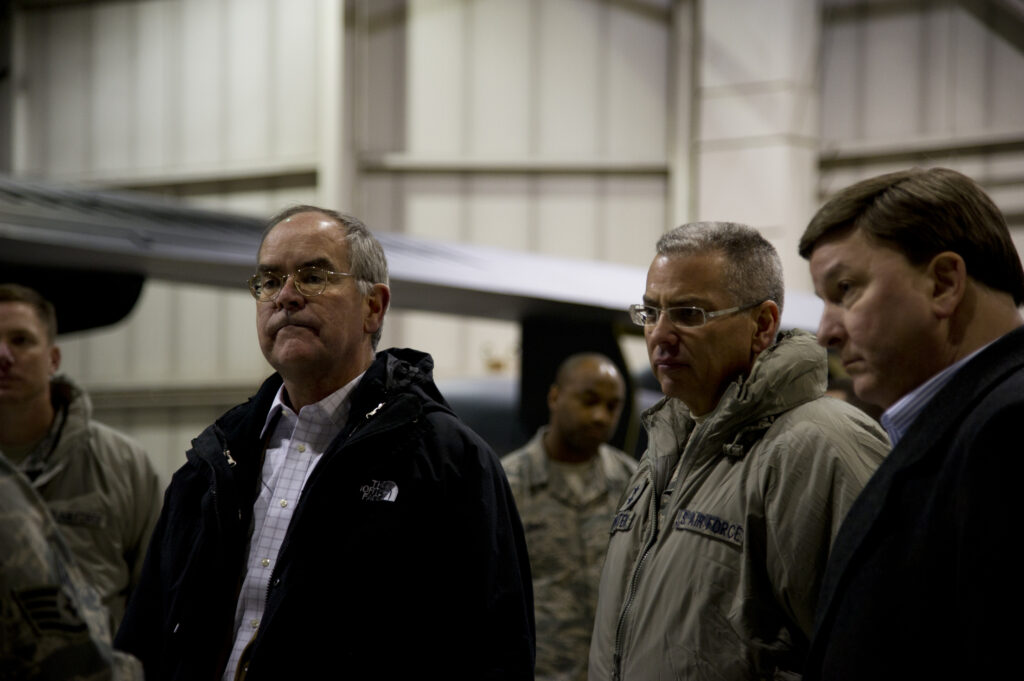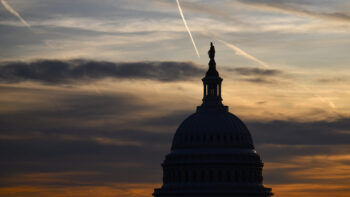
Rep. Mike Rogers (far right), and Rep. Jim Cooper (far left), tour a missile alert facility at Minot Air Force Base.
WASHINGTON: Rep. Jim Cooper, chairman of the House Armed Services strategic forces subcommittee, said he thinks lawmakers will fully fund the Space Force and Space Command 2022 budget wish lists — which total nearly $900 million — on top of the official DoD request of $17.4 billion.
“The Space Command unfunded priorities list is only about $60 million, which in Washington terms is chicken feed. Gen. [Jay] Raymond’s Space Force list is more robust, at some $800 million. But this is all very doable,” he told the National Security Space Association (NSSA) today.
Cooper is one of the founding fathers of the Space Force, with his Republican colleague Rep. Mike Rogers. Thus, it is no surprise that he waxed super supportive of the new service’s fiscal 2022 budget request. His enthusiasm may not be matched by other lawmakers, especially those on the appropriations committees. Indeed, one DoD budget analyst we spoke to expressed much less optimism about the UPL funds, given the “constrained budget environment.”
Space Command’s head Gen. Jim Dickinson petitioned Congress for a bump of $67 million in his unfunded priorities list (UPL). This includes $26.8 million to bring the command up to full operational capability, and another $30.2 million to “bridge space protection gaps,” for example by allowing the command to stand up 24/7 space domain awareness operations. Finally, the list includes $10 million for a new Joint Space Rapid Experimentation and Demonstration pilot program, designed to speed innovative tech to the field.
The Space Force asked for $832 million in extra funds for 2022, including $279 million in classified programs and $113 million for new types of missions such as deep space surveillance and providing space-based tactical intelligence, surveillance and reconnaissance. The extra funds for classified programs are particularly of interest, as the 2022 budget request itself also includes a significant increase for classified spending over last year.
Mike Tierney, long time space budget guru at Velos, told the NSSA webinar today that the Space Force 2022 budget request for research, development, test and evaluation (RTD&E) on classified programs jumped from $3.7 billion to $4.6 billion — “a big bogey” of nearly $1 billion. Further, he said, “two senior Space Force and Air Force officials have basically confirmed that a lot of that is on the new classified program side — $800 million of the classified funding is in new classified programs.”
On the issue of space acquisition reform, which was one of the leading drivers of the congressional push for the Space Force in the first place, Cooper also took a slightly less critical tone than some of his congressional colleagues about lack of movement by DoD and the Department of the Air Force, which is in charge of space acquisition.
The 2020 NDAA required that the Air Force appoint a Senate-confirmed assistant secretary for space acquisition and integration. That person, the act said, “will “synchronize with the Air Force Service Acquisition Executive on all space system efforts, and take on Service Acquisition Executive responsibilities for space systems and programs effective on October 1, 2022.”
“There’s been a dispute, as you know, within the Pentagon about whether the October 2022 date is really the day we need to focus or whether it’s sooner. I’d like it to be sooner, but this is one of those umbilical cord questions,” he said.
“We can figure this out because, remember, we’re all on the same team here,” he continued. “Sometimes the fiercest rivalries are within the departments or between the departments and the Pentagon. So let’s not let the politics of the Puzzle Palace dominate here. We can and must figure this out.”
Acting Air Force Secretary John Roth told the HASC yesterday: “It’s an important position and we really do need to fill it.” Pressed by Rogers for when nominee would be named, Roth simply noted that that is not his decision.
Likewise, Cooper today said that as to whom President Joe Biden might nominate: “that’s above my pay grade.”
When that might happen is anyone’s guess. One DoD official keeping a close eye on the question said that they hadn’t even seen a shortlist of prospective nominees yet circulated.
Another big question looming is when DoD’s budget will actually be appropriated. Todd Harrison, head of the Aerospace Project at the Center for Strategic and International Studies, told the webinar that he expects there to be an extended Continuing Resolution of stop-gap funding given the administration’s lateness in issuing the request.
“I’m not expecting that we’re going to see appropriations enacted until till December or January,” he said.
Pass a preemptive CR, deal with inflation and watch the debt limit: 3 tasks for Congress
John Ferrari and Elaine McCusker of AEI argue in this op-ed that Congress needs to act quickly to ensure American national security before getting bogged down in election season.


























